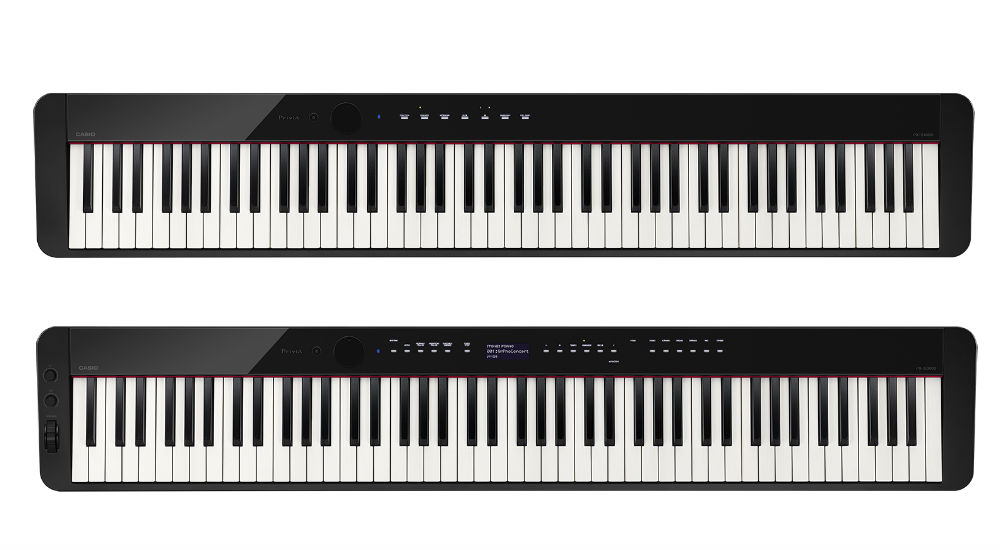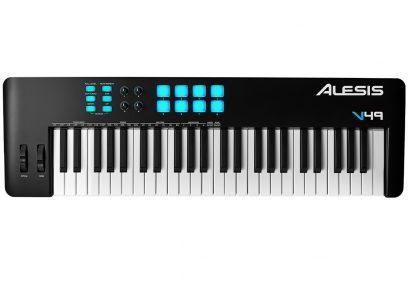We unzipped the diminutive little gig bags and sure enough there lay two full scale 88 key pianos, but there was something indeed different about them. They just looked so…..so…manageable!?! Compared to the traditional, hulking units we were used to, these looked and felt like something completely new.
Piano players have had a historically rough trot when it comes to portability. Authentic key feel generally means weighted keys, which coupled with onboard amplification and various other componentry, very quickly adds up generally to a cumbersome, unwieldy unit (there is also something about the dimensions of a full size digital piano in a road case that make it impossible to fit into the back of a family sedan, no matter which angle you place it).
The PX-S1000 and PX-S3000 look to combat this by radically rethinking the dimensions of the traditional Digital Piano and the results are more than impressive.
On unboxing, the first thing that takes one’s eye is the svelte, futuristic aesthetic of the new-look Privia series. The finish is a tasteful glossy, while the controls are minimalistic, with no excess knobs or displays taking up valuable real estate. The PSX-S1000 reduces the control panel to a power button, a master volume knob and seven touch sensitive controls, giving the PX-S1000 a sleek, futuristic look akin to a smart appliance or a piece of designer furniture. While this minimal layout may sound restrictive in theory, rest assured the controls are as intuitive and flexible as one is likely to encounter, and the accompanying Casio Chordana app only further simplifies control of the unit.
Once up and playing, users are treated to a variety of different sounds (18 on the PX-S1000, 700 on the PX-S3000!), with built-in recording functions and Bluetooth connectivity. I found the latter two features made both of these models particularly adept writing tools, giving users the ability to stream demos or backing tracks directly to the speakers of the unit from a smart device of their choice, without affecting the functionality of the digital piano. This was absolutely perfect for writing overdubs or practising accompaniment.
The dimensions of the Digital Piano have traditionally been determined by a couple important factors: the standardisation of the 88 key/seven octave piano and the size of the weighted keys. In order to achieve the petite dimensions of the PX-S series, Casio has redesigned their Tri-Sensor key technology to something more compact. This resulted in their new Smart Scaled Hammer Action technology. I don’t exactly know what this means, but it results in a key action that is precise and light, reminiscent of an upright piano moreso than a grand.
While the PX-S1000 brings full scale functionality and crisp, just-like-the-real-thing key action to perhaps the most lightweight and compact Digital Piano out there, for just a mere 200 grams of weight (!) and a few extra dollars, the PX-S3000 is a classic in the making and the new Swiss Army Knife of the digital piano world.
The 3000 is very similar in appearance to the 1000. It has the same two 8” speakers on the back as the 1000, the same slick power button and volume knob, but you begin to see just how feature packed the 3000 is when you notice the two assignable control knobs above the pitch bend wheel, and the 3-row LED display nestled amongst the capacitive touch buttons. Further examination reveals a USB port and an extra port for an expression pedal on the back of the unit, a feature lacking in the PX-S1000.
The 3000 comes with 700 different sounds to choose from, the ability to layer two tones together, and the ability to split the keyboard between two tones at whatever key you desire. Any synth players out there will be green with envy at the fact that you can split the piano between a bass tone and a lead tone. Gone are the days of stacking keyboards atop one another to play gigs (and the broken keys from when they inevitably fall). The 3000 one-ups the 1000 with the ability to record real-time playing as audio files, instead of just MIDI files, which you can record straight onto a USB plugged into the back of the unit. The 3000 begins to show its hand as a song writing tool when you hit the play button on one of the 200 inbuilt rhythms. With backing tracks of just about every conceivable genre, and the ability to change the tempo of the rhythm on the fly, chalking up a chord progression to fit a melody, or vice versa, way too easy, and a good way to lose a few hours.
The real clincher of the PX-S series is the ability to control the keyboards via a smartphone or tablet. The Chordana Play for Piano app, available for Android and iPhone/iPad, allows you to connect to the Piano units and control the settings through a nice, user friendly display. While the touch controls on the units themselves are fairly intuitive, the Chordana app speeds up customisation considerably, and shows you just how much detail has been put into every feature of the piano. With features such as customisable sounds and effects, tutorial modes for learning songs, and even the ability to write MIDI patterns on the fly, the Chordana app brings a new level of control to digital pianos.

